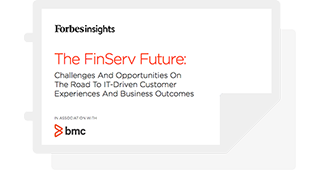The financial services industry has a storied existence, but it’s had to evolve with the times to attract and retain customers, who are now more likely to conduct their business from the palm of their hands. In the ever-evolving, technology-based world, digital transformation is crucial. It was one of the top three business objectives for 50 percent of the 300 U.S.-based, C-level financial executives surveyed for The FinServ Future, a recent Forbes Insights and BMC survey.
According to Amy Brady, CIO and executive vice president for KeyCorp, the financial industry has absolutely been affected by the improved usability that tech has created in other sectors. “Customer expectations of our industry are changing so incredibly rapidly, largely based on their digital experiences in other industries that have bled into what they expect from ours,” she says in the Forbes Insights study.
The need for speed
Mobile-first is a big area driving transformation, and it’s becoming a competitive differentiator with the rise of 5G. “In every segment, in every service, customers want fast, seamless digital experiences at their fingertips. With high-speed, low-latency 5G wireless networking on the immediate horizon, the rate of change and accompanying pressures will only grow,” Mastercard president of operations and technology, Ed McLaughlin, tells Forbes Insights. “Right now, for many consumers, if it’s not instant, it’s broken. 5G will speed up everything.”
That said, it’s important to keep in mind that just because you can access customers everywhere, it doesn’t mean you should. Scott Blandford, chief digital officer and head of technology at TIAA Financial Solutions, prefers the concept of, “digital lightness,” telling Forbes Insights, “Simplif[y] and distil[l] the messaging with fewer words and fewer images…[and with] deep personalization…so you can focus on the right stuff.”
While online access and tools are getting faster, the flip side of that is customers who still want a personal touch to go with their automated processes, according to Jeremy Balkin, head of innovation and strategic digital partnerships at HSBC Bank USA “The most satisfied customers are those who are engaged in both the digital and physical channels,” he points out to Forbes Insights.
Change is the only constant
Seventy-five percent of survey respondents recognize the mounting pressure to bring new services to market more quickly and provide superior customer service in an increasingly competitive market that now includes fintechs, cloud providers, and API-driven service providers. HSBC Bank’s Balkin says there’s no time to waste in creating a forward-thinking solution. “Here in the U.S., in the world’s largest economy, with the deepest, most concentrated banking sectors, we need to be fostering innovation and digitization to meet and exceed customer expectations,” he shares with Forbes insights. “I think it’s incumbent upon all of us.”
One key component to being ready for digital transformation is change readiness. Financial institutions must be able to nimbly navigate an ever-changing landscape. “Gone are the days when we put in a platform that [runs] for 30 years. We’re finding now that five years later, you may be ripping it out to put the next thing in,” explains KeyCorp’s Brady. “So, it’s really important to have change readiness in your organization and to know your employees can absorb that amount of change.”
Start with a plan
Looking ahead, many survey respondents are already in planning mode, assessing which technologies make the most sense for their business.
- 56 percent plan to significantly increase the use of workload automation.
- 61 percent plan to significantly increase the use of capacity management.
- 76 percent plan to significantly increase the use of security vulnerability analysis.
- 93 percent plan to invest more in artificial intelligence (AI) and machine learning (ML).
Drawing the most interest as a transformative technology is cloud services, with 72 percent of the survey’s results, and application programming interface (API) integration isn’t far behind with 67 percent. Despite the ambition to get there as soon as possible, challenges still remain. Over 91 percent of surveyed executives say they face constraints implementing and integrating advanced technologies, with the need to prove return on investment (ROI) and value creation selected by 42 percent as the chief bottleneck. Right behind that, selecting the right partners was a concern for 30 percent, and finding enough time to commit to innovation, 26 percent.
For more information on digital transformation and other issues at the forefront of the financial services industry’s digital evolution, check out The FinServ Future.
The FinServ Future: Challenges And Opportunities On The Road To IT-Driven Customer Experiences And Business Outcomes
These postings are my own and do not necessarily represent BMC's position, strategies, or opinion.
See an error or have a suggestion? Please let us know by emailing blogs@bmc.com.







